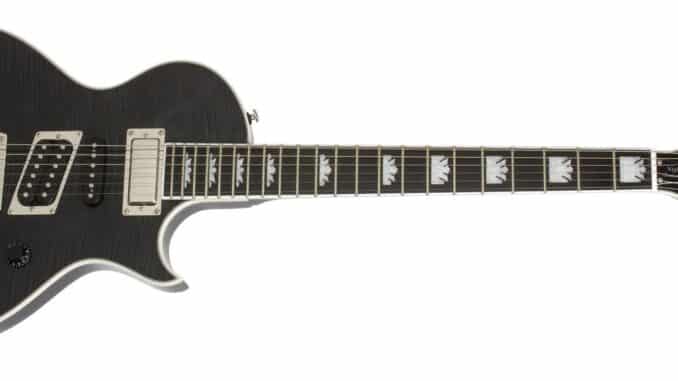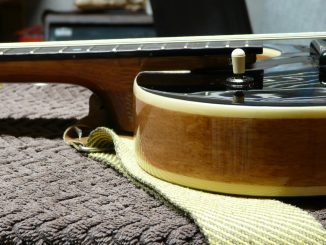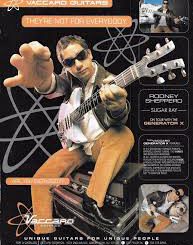
The hard-working folks at Epiphone Guitars have stomped on the gas pedal as they bring the 2011 Nighthawk to the marketplace. Public opinion about the Gibson Nighthawk has always run fairly high, as the older models are slowly climbing the rungs of the sought-after ladder, but this Epiphone version – for all of the interesting factory tweaks it’s been given – has one thing going for it that can be best described as compelling (if not stunning): It’s only four hundred bucks!
The Epiphone Nighthawk also has a solid mahogany body, unlike the poplar Gibson, with the kind of flamed maple top (non-arched) that we’ve come to expect from Epiphone in recent years. It also has an ebony fretboard and push-pull coil-splitters for the two humbuckers that surround the single coil pickup in between them. With it’s sharp cutaway horn, slim waist and wide bottom, it is indeed a handsome instrument (or sexy, depending on how you look at it).
Throw in the Grover tuners, nickel hardware and gawdy mother-of-pearl inlays, and you’ve got a guitar whose makers were clearly trying to meld quality with artistry – which they’ve achieved in some ways. The only problem with following such a path is the tendency to run into situations where design and engineering keep stepping on each other’s toes.
The most obvious example of this is the Nighthawk’s signature feature, the slant-mounted bridge pickup. As with nearly all lower-priced guitars, many players like to “mod” their Nighthawks out, a phenomenon that holds true for both the Epi and Gibby models (and will, at $399, likely apply to this one). The only realistic option for replacing the bridge humbucker, aside from having it rewound to your own liking, is to buy the Epiphone SuperHawk humbucker (much the same as Gibson’s R500 series).

The bridge, to a certain degree, confounds conventional wisdom. To be sure, there’s nothing wrong with running your strings across a LockTone Tune-o-Matic with independent saddle adjustment – it’s the fact that it’s trapezoidal. It stands in immediate geometric contrast to the slanted humbucker just a couple of inches away from it. This is isn’t detrimental, or really even distracting, it’s just off-putting to the eye somehow. The same can be said of the gaudy MOP inlay pattern, a widespread crown that will no doubt be the envy of Burger King district managers the world over.
Despite all (or any) of that, the playability and versatility of this guitar still makes it one that many serious players will want to have in their entire collection. The triple pickups, wired up to a five-channel selector, plus the coil-splitting feature, will blow through most roadblocks with just two knobs. Weighing in at just six and a half pounds, It looks clean, fast and fun with its slim neck and crazy-wide cutaway.
Epiphone, for whatever reason, limited the color scheme to Fireburst, Honeyburst, Trans Amber or Trans Black. The two bursts would be virtually indistinguishable under stage lights. The amber will no doubt bring back some vaguely great memories for those who actually enjoyed the ’70s, and black just has that universal appeal.
The 2011 Epiphone Nighthawk may have a few cosmetic quirks – with quirkiness, mind you, being purely subjective – but it has very few sonic shortcomings. There may be better guitars out there for $399 (although I’m hard-pressed to think of any at the moment), but you’d have to shop around for an awful long time to find one more interesting. All that remains to be seen is how fast this Nighthawk can fly – off the shelves.



![Fender Custom Shop Esquire Guitar [Fender Telecaster] 4 Fender Custom Shop Esquire Guitar [Fender Telecaster]](https://gear-vault.com/wp-content/uploads/2009/08/Fender-Custom-Shop-Esquire-Guitar-Fender-Telecaster-326x245.jpg)

I have two questions:
Mechanics:
I wonder if the Epi Nighthawk reissue from china compares quality-wise with the original Epi Nightnawk from the 90ies.
Electric:
It seems, Epiphone has not only spared out the superswitch of the Gibson, but wired the guitar much more simple compared to the original Epiphone: The classic combinations of the two outer humbuckers (full = Les Paul / Split = Telecaster) seem to be missing. Instead, there are odd combinations of one Humbucker with the middle single coil… Is this a valid substitute for the Les Paul / Tele Sound?
Clearly, there will be quality differences between the old Epiphones (which were made in Korea) and the newer Chinese versions, a fact which is reflected in the price. As to your other point, a lot of buyers are interested in the new Nighthawk because they want to mod it to fit their tastes. Once you get into the guts, if you know what you’re doing, you can solder it up any old way you want. Stock is stock; what are you gonna do?
Epiphone trans purple nighthawk guitar – I am looking for one – any ideas where I can but one?